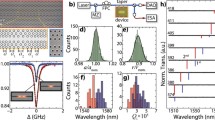Abstract
Photonic crystal cavities facilitate novel applications demanding the efficient emission of incoherent light. This unique property arises when combining a relatively high quality factor of the cavity modes with a tight spatial constriction of the modes. While spontaneous emission is desired in these applications the stimulated emission must be kept low. A measure for the spontaneous emission enhancement is the local density of optical states (LDOS). Due to the complicated three dimensional geometry of photonic crystal cavities the LDOS quantity has to be computed numerically. In this work, we present the computation of the LDOS by means of a 3D Finite Element (FE) Maxwell Solver. The solver applies a sophisticated symmetry handling to reduce the problem size and provides perfectly matched layers to simulate open boundaries. Different photonic crystal cavity designs have been investigated for their spontaneous emission enhancement by means of this FE solver. The simulation results have been compared to photoluminescence characterizations of fabricated cavities. The excellent agreement of simulations and characterizations results confirms the performance and the accuracy of the 3D FE Maxwell Solver.
Similar content being viewed by others
References
Ainsworth M. and Coyle J. (2003). Hierarchic finite element bases on unstructured tetrahedral meshes. Int. J. Numer. Meth. Eng. 58: 2103–2130
Akahane Y., Asano T., Song B.-S. and Noda S. (2003). High-Q photonic nanocavity in a two-dimensional photonic crystal. Nature 425: 944–947
Alivisatos P. (2004). The use of nanochrystals in biological detection. Nat. Biotechnol. 22: 47–52
Berenger J.-P. (1995). A perfectly matched layer for the absorption of electromagnetic waves. J. Comput. Phys. 114: 185–200
Coldren, L.A., Corzine, S.W.: Diode Lasers and Photonic Integrated Circuits. John Wiley (1995)
Fiore A., Oesterle U., Stanley R.P., Houdré R., Lelarge F., Ilegems M., Borri P., Langbein W., Birkedal D., Hvam J.M., Cantoni M. and Bobard F. (2001). Structural and Electrooptical Characteristics of Quantum Dots Emitting at 1.3μm on Gallium Arsenide. IEEE J. Quantum Elect. 37: 1050–1058
Francardi M., Balet L., Gerardino A., Monat C., Zinoni C., Li L.H., Alloing B., Thomas N.L., Houdré R. and Fiore A. (2006). Quantum dot photonic crystal nanocavities at 1300 nm for telecom-wavelength single-photon source. Phys. Status Sol. (c) 3: 3693–3696
Golub, G.H., van Loan C.F.: Matrix Computations. The John Hopkins University Press (1989)
Henkel C. and Sandoghdar V. (1998). Single-molecule spectroscopy near structured dielectrics. Opt. Commun. 158: 250–262
Imamoglu A. (2003). Are quantum dots useful for quantum computation?. Physica E 16: 47–50
Jackson, J.: Classical Electrodynamics. John Wiley (1975)
Jin J.: The Finite Element Method in Electromagnetics, 2nd edn. John Wiley (2002)
Joulain K., Carminati R., Mulet J.-P. and Greffet J.-J. (2003). Definition and measurement of the local density of electromagnetic states close to an interface. Phys. Rev. B 68: 245405
Meschede D. (1992). Radiating atoms in confined space: from spontaneous emission to micromasers. Phys. Rep. 211: 201–250
Nédélec J.C. (1986). A New Family of Mixed Finite Elements in IR3’. Numer. Math. 50: 57–81
Purcell E.M., Torrey H.C. and Pound R.V. (1946). Resonance absorption by nuclear magnetic moments in a solid. Phys. Rev. 69: 37–38
Saad Y. and Schultz M.H. (1986). GMRES: A Generalized Minimal Residual Algorithm for Solving Nonsymmetric Linear Systems. SIAM J. Sci. Stat. Comput. 7: 856–869
Schenk, O.: Scalable Parallel Sparse LU Factorization Methods on Shared Memory Multiprocessors. PhD thesis No. 13515, ETH Zürich. (2000)
Song B.-S., Noda S., Asano T. and Akahane Y. (2005). Ultra-high-Q photonic double heterostructure nanocavity. Nat. Mat. 4: 207–210
Streiff M., Witzig A., Pfeiffer M., Royo P. and Fichtner W. (2003). A Comprehensive VCSEL Device Simulator. IEEE J. Sel. Top. Quant. 9: 879–891
Streubel K., Linder N., Wirth R. and Jaeger A. (2002). High brightness AlGaInP light-emitting diodes. IEEE J. Sel. Top. Quant. 8: 312–332
Tai, C.T.: Dyadic Green Functions in Electromagnetic Theory. IEEE Press (1994)
Teixeira F.L. and Chew W.C. (2000). Complex space approach to perfectly matched layers: a review and some new developments. Int. J. Numer. Model. 13: 441–455
Vučković J., Lončar M., Mabuchi H. and Scherer A. (2002). Optimization of the Q factor in photonic crystal microcavities. IEEE J. Quantum Elect. 38: 850–856
Wang L.-W., Kim J. and Zunger A. (1999). Electronic structures of [110]-faceted self-assembled pyramidal InAs/GaAs quantum dots. Phys. Rev. B 59: 5678–5687
Witzigmann B., Witzig A. and Fichtner W. (2000). A multidimensional laser simulator for edge-emitters including quantum carrier capture. IEEE T. Electron Dev. 47: 1926–1934
Author information
Authors and Affiliations
Corresponding author
Rights and permissions
About this article
Cite this article
Römer, F., Witzigmann, B., Chinellato, O. et al. Investigation of the Purcell effect in photonic crystal cavities with a 3D Finite Element Maxwell Solver. Opt Quant Electron 39, 341–352 (2007). https://doi.org/10.1007/s11082-007-9089-1
Received:
Revised:
Accepted:
Published:
Issue Date:
DOI: https://doi.org/10.1007/s11082-007-9089-1




